RAF Bircham Newton
In autumn 1961 I sat the aptitude and medical tests at the dismal RAF Recruiting Office (shared with The Royal Marines) in a back street near Liverpool Exchange station, and then in November went on to the Youth Selection Centre at RAF Cardington for interviews and further selection tests. We were accommodated in rather cold wooden huts with a coke burning stove in the centre, and many of the staff seemed to be disgruntled conscripts (National Servicemen) who thought we were mad even to consider joining up, especially as Regulars! I passed the selection process and was accepted for entry in spring 1962. Reluctantly, my father signed the papers giving me permission to enlist as a sixteen-year-old; he had held higher hopes for me.
Joining instructions and a Railway Warrant (RAF F.413) duly arrived by post, and on Monday 7th May 1962 I left home. My father drove me to Wallasey Village station with my suitcase, we shook hands, and I was on my own and on my way. I lugged my suitcase from the Mersey Underground which terminated in those days at Liverpool Central (Low Level), across the centre of Liverpool on foot to Lime Street Station and then travelled by a succession of cross-country steam trains to Kings Lynn and onwards to Heacham railway station in Norfolk where I and a number of other recruits all arrived together in the late afternoon. We were greeted (if that is the correct expression) by Cpl ‘Ginge’ Turner, RAF Regiment, who was to be our mentor and tormentor for the next twenty months. We threw our luggage into the back of a waiting blue RAF 3-tonner and clambered aboard an ancient blue RAF bus for the short journey to RAF Bircham Newton, and our new home in the twelve-man billets of Zeebrugge Block. We were told it was too late in the day to be formally enlisted by the RAF Record Office detachment, who (we joked), clearly had a very good trade union, so that waited until the next morning 8th May, thus depriving us of a day’s pay for the 7th. That was our first introduction to the devious ways of the Royal Air Force, and thus started the 46th Entry of RAF Administrative Apprentices, the latest intake of ‘Trenchard’s Brats’. (Marshal of the Royal Air Force Lord Trenchard, known as the father of the RAF, had introduced the Apprentice scheme to the Service, initially in the technical/engineering trades, but later extended to include a wider range of trades).
Having been issued our uniforms, we were each given a cardboard box and all our civilian clothes were packed into them and sent home. For the next year and a half, we were required to wear uniform at all times. In the proper military tradition, we underwent a regime of physical training, square-bashing and basic soldiering. We learned how to strip and reassemble a Bren gun in a matter of seconds, change the barrel, and how to do a bayonet charge complete with ferocious blood curdling screams on poor unsuspecting dummies stuffed with straw. Our weapons training was mainly on the Bren and Sten guns and the Lee Enfield .303 bolt action rifle, which were the standard RAF weapons of the day. Cpl ‘Ginge’ Turner was assisted in knocking us into shape by four other DI’s (Drill Instructors) and Gunners, two of whom were National Servicemen who were demobbed by the end of 1962 when the last conscripts left the Service. We spent hours drilling on the square, including every Saturday morning. Slackness could result in an individual being made to double around the Parade Ground, sometimes with his rifle above his head. Our PTI’s seemed to take a sadistic pleasure in taking us to swim at Hunstanton open air pool (unheated of course) on what always seemed to be cold, windy days, and we emerged absolutely blue and shivering. I don’t remember the PTI’s joining us in the water. At times like that I wondered why I had joined up.
Zeebrugge Block – Billet Two
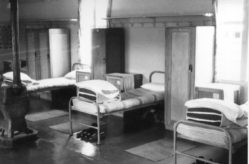
Each morning we had to strip our beds and make blanket packs which we left at the foot of the bed, with ‘bulled’ boots and shoes placed under the bed, uniforms and clothes hanging or stacked in the proper order in the lockers which we were not allowed to lock because they had to be left open for inspection, towel folded over the small locker with a white pint mug upside down on top of it. The barrack room linoleum floors were highly polished by hand swung bumpers with felt pads underneath them. We never walked on them without felt pads underneath our boots. We cleaned the place and surrounds thoroughly, and the whole block would sparkle, but the Corporal on his daily inspection would delight in finding fault. Once a week our Flight Commander (Flt Lt Colwill) would inspect. He was far more reasonable than the Corporal.
On a roster basis we worked in the Apprentices’ Mess, behind the counter, to ladle out portions under the eagle eye of the Corporal cook. Every evening was a ‘domestic evening’ otherwise known as a ‘bull night’. We polished the floors, cleaned the ablutions, cleaned the windows and the barrack block surrounds, dusted, pressed uniforms and clothes, sewed and darned as needed, polished our boots, buttons (which were brass) and other brasses such as on webbing, blancoed and polished our webbing (which was normally blue). Sometimes we would have to scrub the webbing belt and rifle sling clean and change them from blue to white for ceremonial use, and then back to blue again. As ‘junior entry’ (there were three Apprentice Entries each year) we were expected to ‘bull’ for the senior entry, which meant clean their kit and billets and do other chores for them. If you transgressed it meant a ‘senior entry court martial’ which was far more frightening than the real thing, as was the punishment, which, at the upper end of the scale, could involve being forced to jump from an upstairs (first floor) window. I don’t know if it was ever carried out, but it was certainly threatened. I was on the receiving end of such a ‘court martial’ once, but with a lesser punishment.
Sometimes the senior entry would raid our billets during the night when we were asleep, spinning or tipping our beds, which would generally cause them to fall apart, and we were trapped beneath the frame, face to the floor, until we could extricate ourselves. Naturally, this activity caused marks on our highly polished floors which we would then have to work to remove before inspection the following morning. Alternatively, in the middle of the night, in addition to raiding our billets, they would then make us double across the domestic site and parade ground to their block for some other petty torment. Boys will be boys.
Escape To Kings Lynn
For the first six weeks we were confined to barracks, thereafter we were allowed out of camp on Saturday afternoons. We had to sign out at the Guardroom which was manned by the RAF Police, and sign back in again on our return. The RAF Police (known as ‘Snowdrops’ because of their white caps), who in those days also wore white blancoed anklets, webbing belt and cross strap, inspected us before we left camp, and would routinely send us back to our billets to polish our buttons or boots again, or even the rear of our cap badge, despite the fact that they were sparkling clean. We soon learned to report to the Guardroom half an hour before the bus left, to allow time to play the RAF Police’s silly games, otherwise we would miss the bus and our only chance to leave camp that week.
On the small amount we were paid we could just about afford the return bus fare to Kings Lynn (about an hour’s journey) and a cup of tea at the YMCA. The last bus back was early evening, so we were in plenty of time for 21.30 bed-check and 22.00 lights out, which was strictly enforced. At camp we had the Apprentices’ NAAFI canteen, which was alcohol free and extremely basic. We were prohibited from mixing socially with airmen or visiting their NAAFI.
We did enjoy one ‘educational’ visit on duty to RAF Coltishall for their Open Day in mid-1962 where on static display was one of the RAF’s Thor IRBMs, and the flying display (including Hunter, Valiant, Victor and Vulcan aircraft) was fast, low and (to me) very impressive. The Thor IRBMs played a crucial role in the 1962 crisis when Russia was forced to back down and remove its own missiles from Cuba. I remember passing a Thor base in Lincolnshire (RAF Hemswell I believe) later that year and seeing one Thor missile vertical on its launch pad (presumably complete with its W49 nuclear warhead), ready for action. It was a chilling sight.
Daily Routine
Every working day (Monday to Saturday) started with a working parade. We would form up in Flights outside our billets to be inspected, then march onto the parade ground to form up into Squadrons and Wings where we were inspected again. The ensign would then be raised with due ceremony; on special occasions it would be broken at the peak. (This means that the ensign was rolled up neatly, secured by a thread or string and held together with a match, raised to the peak, and at the appropriate moment a tug on the rope snapped the match and the ensign would unfurl). The whole parade, led by the Apprentice Band, would then march past the ensign saluting or giving an eyes-right as appropriate, and reform. Dress was working dress (hairy blue battledress for the lucky ones, for others including me it was hairy National Service best blues which were being issued in lieu to use them up – which meant more brass buttons to clean, even the flies had brass buttons). We wore polished blue webbing belts and small packs with cross strap and brass accoutrements, berets with brass badges and a coloured backing disc to denote trade. Our working shirts were grey/blue with detachable collars fixed by collar studs. In winter we wore greatcoats, with brass buttons of course, some of which still bore Kings’ Crowns. When the ceremonial and parade was complete, we would be marched-off by Flights to our programmed duties, be it trade classes, drill, physical fitness, ground defence training, general Service lectures, education classes, Padre’s hour, fatigues or anything else.
At one stage I joined the Apprentice Band, but I was not musically inclined. I started off on the trumpet but was so bad that I was told just to pretend to play it on daily working parades. I was then moved to the side drum, with a little more success, but did quite well on the bass drum which became ‘my’ instrument. I also trained as a drum major who, with his mace, leads the band, and indeed the whole parade when marching past the saluting base. I was quite good at this so long as I didn’t try to throw the mace in the air and have to catch it. One day the Apprentice Drum Major was absent for some reason, so I had to take over in his place. I had, of course, been on working parade every day for several months and knew all the orders and drill movements perfectly and I thought that I did it really well. I had, except for one thing. When marching past with eyes-right I failed to salute the ensign. Normally, only officers salute but the one exception is the drum-major and no-one had told me that. The Band Sergeant certainly did afterwards.
Wednesday afternoons were given over to sport, and Saturday mornings were always devoted to drill. Although Church Parades generally were a thing of the past, on special occasions we did have them; we formed up in Flights outside our billets as usual, were inspected and then marched to Church. We marched everywhere, even to meals. We were told not to march around the camp by ourselves. If possible, we had to wait until a Flight or Section passed by heading in the right direction, attach ourselves to it, and march with it as far as we could before peeling off to our destination. The main exception was sick parade. One was required to attend meals in the Mess Hall; the Orderly Sergeant was always present to ask, ‘Any Complaints?’ with regard to the food, but if one was ill the fact had to be reported to him and recorded in his report. He then ordered you to attend sick parade at Station Sick Quarters where a medical orderly took your details, and you joined any other ‘malingerers’ waiting to see the MO.
Education Continues
All Apprentices had to attend education classes and achieve passes in the RAF Education Test parts one and two, which were a prerequisite for graduation and promotion. I also attended GCE ‘O’ level classes and gained passes in English Language, and General Paper. These classes were held in the Station Education Centre and taught by RAF Education Officers. At one stage the Padre took a group of us to RAF Amport House (the RAF Chaplain’s School) in Hampshire to attend a Moral Leadership Course; we also visited Salisbury Cathedral which was in the area. Back at base the Padre took Confirmation classes and a group of us were confirmed at Sedgeford Parish Church by the Bishop of Thetford, who had served in the Royal Flying Corps, and who was delighted to see us all in RAF Uniform (No 1 HD), our ‘best blues’ otherwise known as T63s, made of barrathea, and complete with brass buttons of course, and ‘best’ light blue shirts.
Money Matters
Pay depended on age. The lowest rate of pay was for fifteen-year-olds who joined as Boy Entrants. The minimum age for Apprentices was 15 years 6 months, but as a sixteen-year-old (and one of the oldest in my Entry) I was entitled to £2-5s-0d (£2.25p) per week. However, 5/3d (26p) was deducted for National Insurance, 1/9d (about eight and a half new pence) for a haircut which the Service paid directly to the camp barber, a mandatory saving into an RAF POSB (Post Office Savings Bank) account which we were required to open, and the majority was retained in ‘credits’ and paid as a lump sum when we went on leave, so I received 15/- a week (75p) on which to live. From this I had to pay for boot polish, blanco, brasso and anything else needed to maintain my kit. That left very little for luxuries such as a bus fare into Kings Lynn, film for my camera, or a cup of tea in the NAAFI. Of course, we lived ‘all found’, meaning that we did not pay for meals in the Mess Hall, or for accommodation in barracks. Uniform items were ‘lifed’, so if you needed to replace an item of kit before its allocated ‘life’ was up, the cost was deducted directly from ones pay account.
Everyone was paid in cash weekly by ‘witnessed’ pay parades. We paraded in a hangar. The paying officer sat at a trestle table covered with an RAF grey blanket, with a witness stood either side of him. DIs called us forward by alphabetical letter, A’s then B’s etc., to a point about 10 yards short of the table until all those to be paid (many hundreds of us) were present in numerous rows about 50 men wide. The parade was stood at ease and everyone told to hold their Identity Card (RAF F.1250) in their left hand. We were called forward alphabetically from the Acquittance Roll, in my case ‘Dyer J’. One came smartly to attention, replied loudly ‘Sir, 243’ (or whatever the last 3 of one’s Service Number was), marched smartly up to the table, halted with a stamp of the feet in proper parade ground style, saluted and showed one’s Identity Card. In a continuing and seamless movement, one picked up from the table the amount of money placed in front of you by the paying officer and witnessed by another officer in response to the amount read out from the Acquittance Roll, turned to the left, marched smartly round the assembled parade, exited the hangar and formed up outside by Flights ready to march off again. The process took quite some time. Occasionally we were ‘coined’ a shilling, from our credits, which was then taken off us as we left the hangar, as a donation to the RAF Benevolent Fund. One did not argue!
Alamein Block – Billet Twelve
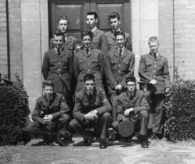
Following the graduation of our senior entry (the 42nd Entry) we moved from Zeebrugge Block to Alamein Block, a larger and more modern building on the opposite side of the Parade Square, but a longer distance to march to and from meals. The regime of ‘bull’, inspections etc. remained unchanged.
Military training exercises were conducted in the abandoned bomb dump, which was a maze of concrete and earth blast walls and bunkers. We used Geiger counters to find radioactive sources hidden around the place, and we picked up those radioactive sources with our bare hands when we found them. We did standard drills in the gas chamber with Tear Gas (an earlier equivalent of CS Gas), with and without respirators. Live firing exercises were conducted in the Stanford Training Area, and we all had to take our turn in the butts (while wearing our WW2 pattern steel helmets), with live rounds flying not far above our heads, using a wooden pointer to indicate hits on the targets. We also practiced ‘advance and shoot’. This required us to run 25 yards, go to ground, shoot at the target, get up again, run another 25 yards, go to ground and shoot again, and so on down the length of a long range. Shooting accuracy was not so good in this scenario! I found that firing .303 rounds bruised my shoulder and was extremely painful to my ears; we did not have ear or hearing protection in those days, and it would be many years before small foam ear-plugs were introduced to give some limited amount of protection.
On one occasion I marched part of the length of the Peddar’s Way with a group of the 45th Entry, camping en route. We did cheat and hitch-hiked part of the way! Our standard footwear for everyday use and also on exercise was ‘Ammo Boots’ with steel studded leather soles and steel reinforced heel. These were very unforgiving and caused many blisters, particularly on a long march. Nonetheless, they gave off a satisfying crunch when marching on a hard surface such as a parade ground and helped maintain everyone in time and in step. The military had not yet adopted rubber soled footwear.
Unusually, because selection was quite strict, one member of the 46th Entry was an ex Borstal Boy. (Borstal was a fairly tough type of youth detention centre for young delinquents). This may have been an experiment by the recruiters. He did not last long and bought himself out of the Service (purchased his discharge) quite early on saying that he found the RAF Apprenticeship too tough, tougher than Borstal.
First Flight
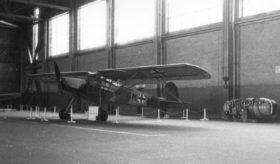
For the 1962 Air Officer Commanding’s annual inspection, AOC 22 Gp, AVM Chacksfield, arrived by Anson and landed on our grass airfield; the only hardstandings were around the hangars and ATC tower. One of our hangars was used to store some historic aircraft. We had a Spitfire, Javelin, Vampire, Venom, a captured German Feisler Storch and one or two others. From time to time a Flight of Chipmunks would arrive to give us Air Experience.
For my first ever flight (in June 1962) I reported with other Apprentices to the Air Traffic Control Tower on the edge of the hardstanding near the hangars. A sergeant displayed his undoubted command of Anglo-Saxon in requiring us to remove our Ammo Boots and put on plimsolls before approaching our allotted Chipmunk. My pilot was Wg Cdr E Baldwin, an ex-Wartime Pathfinder, and he wore the distinctive metal ‘Pathfinder’ Wings on his uniform beneath his RAF Wings and medal ribbons. He was OC Junior Command and Staff School which was also located at RAF Bircham Newton. Wg Cdr Baldwin and I donned parachutes and the traditional ‘Biggles’ type leather head cover incorporating earphones and microphone so that we could communicate. He started the engine, taxied off the hard-standing on to the grass runway and before I realised it, we were airborne and heading for Wells-Next-the-Sea. After fumbling around for a while, I found the intercom switch and could then answer the pilot’s two questions which were: ‘Is this your first flight?’ and ‘Would you like to do aerobatics?’ I answered ‘Yes Sir’ to both; one did not say ‘no’ to an officer, and certainly not to a Wing Commander. When we landed, I felt rather queasy, but at least I had survived the loops and rolls without disgracing myself. Now I was a proper airman!
One rare ‘treat’ that I and some of the other apprentices in my billet had, was a Saturday afternoon in the Bowling Alley at RAF Sculthorpe (a US Air Force Base operating B50 Superfortresses), five miles down the road. The American airmen were kind to us and showed us how to bowl properly, but our paltry apprentice pay did not go far having been converted into US Dollars which was the only currency used on the base. We had travelled there by bus, but had to walk back to Bircham, signing in at the guardroom just in time to be back in the billet before bed-check.
RAF Bircham Newton closed in December 1962, with great ceremony. The Reviewing Officer was our AOC-in-C Technical Training Command, Air Marshal Sir Alfred Earle, accompanied by the new AOC 22 Gp, AVM Case, and the ceremonial was undertaken by the Queen’s Colour Squadron with the Central Band of the RAF. Among the distinguished guests was Marshal of the Royal Air Force Lord Tedder, a former CO of 207 Sqn when it was based at Bircham Newton from 1920 – 1922. We apprentices were spectators at the parade which was held in a hangar, in the evening, and which concluded with The Last Post and the lowering of the RAF Ensign for the final time at Bircham. So ended my first posting in the RAF, and I was not yet half-way through my training.
RAF Hereford

We were sent home for Christmas and New Year, with a Railway Warrant and instructions to report to RAF Hereford (a Boy Entrant camp) at Credenhill (which is now the 22 SAS base) on our return from leave. The winter of 1962/3 was the coldest and worst for many years, with heavy snow and ice which lay on the ground for months. It was at this time that I took and passed my driving test in Birkenhead in my father’s car, the Ford Popular. It was taken in conditions of ice, snow and poor visibility, during the rush hour, and around the Mersey Tunnel entrance. It was a real test, and I was pleased with myself to have passed it, first time.
The Big Freeze
The day before my leave expired I, in common with many hundreds of others, received a telegram from RAF Hereford extending my leave by 7 days because the camp was frozen solid and virtually cut off by deep snow. When I reported in, conditions were little better. We found that the base was a wartime hutted camp which was clearly on its last legs. The wooden huts which were our billets in Trenchard Lines were falling apart; one could see a crack of daylight through a corner where the exterior walls didn’t quite meet. Heating was by coke stove, one at either end of the 20-man billet. For inspection, the stoves needed to be cleaned and black-leaded. Some of the ablutions (in a row of adjoining huts) were frozen solid and unusable and we had to search to find running water and a toilet that was working.
All the camp roads were covered in compacted ice which stayed there for over three months. Trenchard Mess (our Apprentice and Boy Entrant cookhouse) was also a collection of wooden huts with coke stoves. It was so cold that when we got a mug of tea from the urn and some spilt onto the formica table tops it froze after a while. The food was terrible, and conditions on base so difficult that life turned into a huge endurance test which one tried to survive. We continued our training in sub-zero temperatures even indoors, dressed in greatcoats and woollen gloves while trying to write shorthand and type it back. It was a character-building experience! Each hut was issued with 2 small containers of coke per week (per stove) for heating purposes. This was utterly inadequate and would barely last a day, so we all used to raid the coke storage area for additional fuel on a regular basis, dodging the ‘Snowdrops’ as we went, to avoid arrest.
One amusing anecdote from that time concerned our flight as it was being marched from one place to another on the icy roads. We were wearing our Ammo Boots on which the steel studs were worn flat by this time, and which were absolutely lethal on the thick ice. An officer approached going in the opposite direction, so our Senior Man ordered an ‘eyes right’, the front rank lost their footing and fell over, and the rest of the flight followed. The officer also lost his footing and ended up on his back; it was all rather undignified, with 15 or so of us in a heap on the ground and mouthing ripe comments.
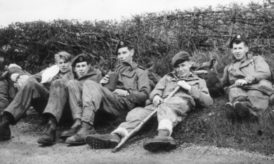
I went down with influenza at some point during the winter and ended up in Station Sick Quarters for a few days; there was quite an epidemic of it on base. At Easter we went on leave. Previously it had been the practice to march everyone down to Credenhill station, near the base, to catch a series of troop trains into Hereford and onwards. For some unknown reason we were spared this and were bussed into Hereford direct. We then caught very decrepit steam hauled special trains (as far as Birmingham in my case) and then changed onto scheduled services for our diverse destinations. After Easter the weather began to improve, and conditions on base became easier as everything began to thaw, and things slowly returned to normal. We went on Summer Camp to the Black Mountains above Crickhowell, in Wales, for military training exercises including escape and evasion, and lived under canvas. My two abiding memories of this are the steepness of the hills, and the weight of the jerry cans of water that we had to carry daily from the bowsers in the valley, to our camp up in the hills. Some of us went on the Ten Tors expedition on Dartmoor, but I was not one of them.
Senior Entry
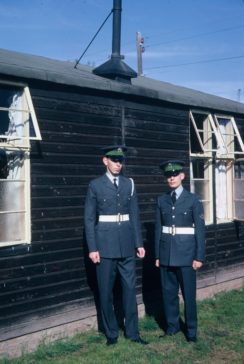
After summer leave my Entry (the 46th) became ‘Senior Entry’; in fact, we were the only Entry remaining of the Administrative Apprentices as we were the final Entry in the scheme. The Boy Entrant scheme was continuing and their 50th Entry was attested in the September. RAF Hereford was being rebuilt and a number of brick-constructed barrack blocks came into use, for the Boy Entrants. We Apprentices stayed on in the Wooden Huts of Trenchard Lines. Being Senior Entry brought with it the privilege of wearing civilian clothes when not on duty. If going off base this meant that you had to wear a suit, with collar and tie of course. The usual rules of booking out and in at the RAF Police Guardroom still applied. On 22 November 1963 I travelled home by train on a ‘48 Hour Pass’ and arrived to the news of the assassination, in Dallas, of President Kennedy.
Administrative Apprentices wore Green hatbands on their SD Caps; Boy Entrants wore Red and White chequered hatbands. There was some antipathy and suspicion between the two groups, and we did not really mix. Apprentices were educationally more advanced and taught to a higher standard than Boy Entrants. Consequently, Apprentices expected to graduate in the rank of Junior Technician (one inverted chevron) in the trade of Clerk Secretarial, whereas Boy Entrants expected to achieve Senior Aircraftman in the lesser trade of Clerk General Duties. Those Boys who did not achieve the requisite standard would graduate as a Leading Aircraftman Clerk Basic, or perhaps even as an Aircraftman First Class. There were also other trades for Apprentices (Pay Accountant and Supplier 1), and even more trades for Boy Entrants, but my particular Entry of Apprentices were all Clerk Secretarial (Clk Sec).
A group of six of us from my Entry clubbed together to buy an old car for £20; it was a 1948 Austin 16 and barely roadworthy. We couldn’t keep it on camp as Apprentice Standing Orders forbade ownership of a car or motorcycle, so we kept it on a street in Hereford where we had bought it. One Saturday afternoon we decided to go for a drive, but it wouldn’t start, so we push-started it on the street, where we were spotted by an instructor who reported us. This led to three of us being charged with disobedience to Apprentice Standing Orders, but we managed to keep the other three out of it.
The three of us duly appeared at an Orderly Room in front of Flt Lt Colwill (our Flight Commander) and then the Squadron Commander and were each awarded 14 days Restrictions (commonly known as Jankers). This meant being confined to camp for 14 days, reporting to the RAF Police at the Guardroom in full marching order with brasses and webbing gleaming several times a day for inspection by the Orderly Officer or Orderly Sergeant, and doing fatigues, usually in the tin-room of the Apprentice and Boy Entrant Mess kitchens. The Corporal cook was always glad of the extra help. It was quite a tough regime on top of our already very busy daily schedule. This was the only time in my career that I was awarded Jankers. Some people seemed to be on it almost continuously, and defaulters (as they were known) made up quite a large number at each Guardroom parade, often as many as twenty or more at a time. There seemed to be a rule that after 28 days continuous Jankers one had to have 48 hours of normal duties before starting any further period of punishment.
Graduation

Towards the end of our 20 months training, excitement mounted, and competition increased for various prestigious awards, and to find out where we were to go on posting. My father came down on 12th December to attend an end of course dinner at a hotel in Hereford for the 46th Entry Apprentices. We were allowed to wear a white shirt with our No 1 HD (Home Dress) Uniform for this evening occasion; another first for us! On the morning of 13th December 1963 there was a joint Service of Dedication in the Station Church for the Apprentices and Boy Entrants of the 46th Entry, then after an early lunch, a joint Graduation Parade, for which the reviewing officer was the SASO at Maintenance Command, Air Vice-Marshal CJR Salmon. It was a bitterly cold, grey, dismal winter’s day; we were all in Greatcoats, white webbing, and had .303 rifles with white straps and fixed bayonets. The Boy Entrant Band led the parade, but the main music was provided by No. 1 Regional Band of the RAF.
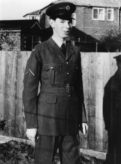
After the parade we wore our new badges of rank which we had sewn onto our No.1 HD tunics the night before, but of course our Greatcoats had covered them on the parade. We then went to the Station Theatre for a prize-giving; it was just like school again, except we were all in RAF uniform. I was now a Junior Technician, and very proud of my one inverted chevron as I marched onto the stage to collect the Air Ministry Prize for First in Shorthand, a Pitman’s Shorthand Dictionary. We were now deemed fit to be let loose on an unsuspecting Air Force, and I found that my first ‘Man Service’ posting was to be RAF Oakington, near Cambridge. This later became an Army camp and later still an Immigration Removal Centre.
« Sniper Of The Skies – Ben Croucher (29th) || Finally Retired And Wrote About It – John Grimwood »